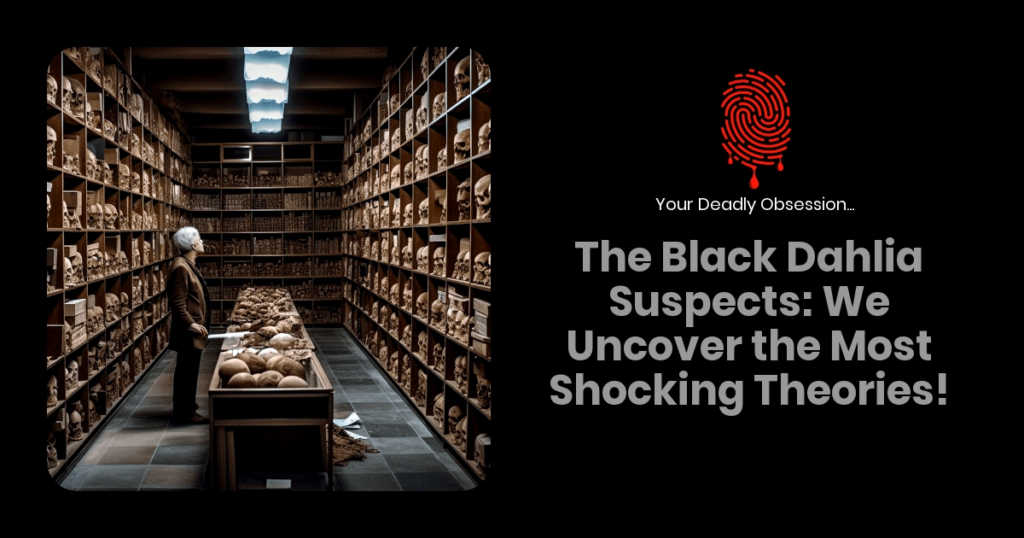We’ve all heard of the chilling and tragic Black Dahlia case, one of the most notorious unsolved murders in history. It’s a gruesome tale that’s captured the fascination of many people for decades now. Elizabeth Short, a young aspiring actress, was found brutally murdered in a vacant lot in Los Angeles in January 1947. The horrible, mutilated condition of her body and the mysterious circumstances surrounding her death have made this case a subject of intense curiosity.

Over the years, we’ve seen a myriad of suspects that’ve been investigated or accused in connection with this chilling crime. Some were simply at the wrong place at the wrong time, while others seemed eerily connected. As we delve into the murky waters of the Black Dahlia case, it’s essential for us to be skeptical yet open-minded when examining the numerous suspects that have surfaced throughout the years.
Since solving the mystery is an ongoing collective endeavor, it’s important for us to pool our resources and put forth our best efforts to uncover the truth. We’ll sift through the web of conjectures, rumors, and raw facts, in hopes of shedding light on this dark and tragic tale. Let’s dive into the shadowy world of the Black Dahlia suspects and try to unravel the enigma that’s persisted for more than 70 years.
The Unsolved Black Dahlia Case
Have you ever wondered about the dark mysteries behind unsolved cases? The Black Dahlia case has captivated us for decades, and we’re here to discuss some intriguing details surrounding it.
On January 15, 1947, the gruesomely mutilated body of aspiring actress and Hollywood hopeful, Elizabeth Short, also known as the ‘Black Dahlia,’ was discovered in Los Angeles. The case has since remained unsolved, despite numerous investigations and countless suspects. There are several reasons why the mystery continues to elude us:
- Lack of forensic evidence: Unfortunately, when the crime occurred, the technology and techniques available were much less sophisticated than what we have today. This has left the case without any solid leads or conclusive evidence.
- The passage of time: As the years have gone by, potential witnesses have passed away, and memories have become foggy. Time has made it challenging to gather new information that might help solve the case.
- Misinformation and lost files: Early in the investigation, newspapers distorted facts to sensationalize the story, causing misinformation to spread. Also, some case files have mysteriously disappeared over time, further complicating our efforts to crack this case open.
So, who could have committed this heinous crime? Below, we’ve compiled a list of the main suspects:
- George Hodel: A prominent Los Angeles doctor who was known for hosting wild parties. His son, Steve Hodel, became a homicide detective and later claimed that his father was the killer, based on some evidence he found.
- Walter Bayley: A surgeon who lived near the crime scene. There’s been speculation that he may have been involved due to his medical knowledge, which would have allowed him to carry out the precise mutilation of Elizabeth Short’s body.
- Leslie Dillon: Dillon, a writer and mortician’s assistant, was investigated by the police at the time. Although he was never charged, many believe he had the motive and means to commit the crime.
- Norman Chandler: The publisher of the Los Angeles Times was also suspected. According to some theories, he had a secret affair with Short and fathered a child with her, which led to the murder.
Despite these intriguing leads and theories, the Black Dahlia case remains an unsolved mystery. The fascination with this case only grows with time, as we continue our quest to unveil the truth. For now, the identity of the killer is still unknown, hidden within the shadows of the past. We’re keeping our fingers crossed, hoping that one day, we’ll finally know who was behind this haunting enigma.
Top Black Dahlia Suspects
Let’s dive right into discussing some of the most well-known suspects in the Black Dahlia case. With so many theories and suspects over the years, it’s no wonder that this case continues to captivate die-hard fans of cold cases, crime and mystery.
One of the most talked-about suspects has got to be Dr. George Hodel. As a prominent physician and surgeon in Los Angeles in the 1940s, he lived close to the murder scene. His own son, Steve Hodel, a former LAPD detective, has spent years conducting an independent investigation to reveal his father’s involvement in not only the Black Dahlia murder, but also other murders.
Another suspect that has drawn attention is Leslie Dillon, a former bellhop and aspiring writer. He was connected to the case after contacting LAPD psychiatrist, Dr. J. Paul De River, claiming to know who committed the crime. His knowledge of the case was unsettling, but Dillon was never officially charged.
Next up is Robert “Red” Manley, the last known person to see Elizabeth Short alive. Elizabeth was last seen at the Biltmore Hotel, where Manley dropped her off on January 9, 1947. He was given a lie detector test, which he passed. Despite this, his involvement can’t be completely ruled out.
It’s also worth mentioning George B. Spangler, who had a fixation on the Black Dahlia case. As a journalist and screenwriter, his obsession led him to write a screenplay implicating himself in the crime. While LAPD’s Behavioral Sciences Unit flagged him as a potential suspect, he was never charged.
Here are some other noteworthy suspects:
- Jack Anderson Wilson (a.k.a. Arnold Smith): A former LAPD informant with a criminal background, Wilson’s name surfaced again in a book detailing Black Dahlia suspects. Authorities had tried to interview him, but Wilson died in a fire before they got the chance.
- Joseph A. Dumais: An Army corporal stationed near Los Angeles, Dumais bragged to friends that he knew Elizabeth and had even dated her. He later recanted his stories, but not without leaving suspicion.
As you can see, there’s no shortage of suspects in this infamous cold case. Each has their own connection to the murder, making it difficult to pin down the true culprit. Even after all these years, the Black Dahlia mystery remains unsolved, continuing to intrigue and captivate us.
George Hodel: A Prime Suspect
George Hodel quickly established himself as a prime suspect in the Black Dahlia case. Let’s dive into the details that make him an intriguing person of interest, shall we?
As a successful physician, Hodel had both wealth and power on his side. In fact, he ran a clinic in Los Angeles that treated many Hollywood stars. But what really drew attention to him was his reputation for hosting wild parties at the notorious Sowden House in the ’40s and ’50s. Rumor has it that illegal abortions were performed in the basement, adding to his notoriety.
His son, Steve Hodel, also plays a significant role in implicating his father. After retiring as an LAPD detective, Steve began investigating the Black Dahlia case in 2001. What he discovered would change his life – he became confident his father was responsible for Elizabeth Short’s death. Steve amassed considerable evidence to support this claim:
- George Hodel’s handwriting was strikingly similar to the letters sent to the police from the Black Dahlia Avenger.
- A recording of George discussing payoffs to police officers implied he had knowledge of and connections to the darker side of law enforcement.
- Black and white photos found in his father’s belongings featured a woman who bore a striking resemblance to Elizabeth Short.
Adding fuel to the fire, expert criminologists believe George Hodel’s knowledge of surgery would have enabled him to commit the gruesome dismemberment. Furthermore, George had a second property close to the crime scene, which could have served as an ideal location for disposing of the body.
However, we should consider that other evidence contradicts Steve’s claims:
- A retired LAPD archivist stated that the handwriting on the Black Dahlia letters didn’t match George Hodel’s.
- The woman in the photos was never definitively identified as Elizabeth Short.
Despite these inconsistencies, George Hodel remains a focal point in our search for the truth about the Black Dahlia murder. His incredible story and the evidence found by his own son keep us wondering if he was, in fact, the killer. Moreover, it’s fascinating to think that if George Hodel was the culprit, the savage truth was hidden for decades behind a mask of money, power, and dark connections.
Walter Bayley: A Surgeon’s Motive
We can’t talk about the Black Dahlia suspects without mentioning Walter Bayley. This guy was a prominent surgeon back in the 1940s, but his life took a twist when he became a suspect in the gruesome murder of Elizabeth Short, notoriously known as the Black Dahlia.
What’s interesting about Bayley is that he lived pretty close to where Elizabeth’s body was discovered. Sure, that doesn’t directly link him to the crime, but it does raise some eyebrows. Plus, this may surprise you, but the way Elizabeth’s body was dissected… Professionals believe it could have been done by someone with medical knowledge. Could Bayley have used his surgical skills for such a macabre act?
Bayley’s motive for the murder may not be so clear cut. Rumors have it that the doctor’s family had connections to Elizabeth, which could have somehow triggered a resentment towards her. But we’re only speculating. There’s also a theory floating around that Bayley might have been suffering from some kind of degenerative brain disease at the time, causing him to act irrationally. Check these out:
- His residence, super close to the crime scene
- The state of Elizabeth’s body, pointing to someone with medical expertise
- The alleged family connections to the victim
- Bayley’s possible brain disease
As captivating as these theories may be, we should note that none of them have solid proof. We’re only able to piece together some intriguing information that paints Bayley as a suspect. We know how much we all love a good crime mystery, but it’s essential to remember that the case remains unsolved.
To sum it up, Walter Bayley is undoubtedly an intriguing figure in the Black Dahlia case. His surgical background, proximity to the crime scene, and potential motives all seem to partially link him to the murder, but the evidence isn’t conclusive. Does this leave us with more questions than answers? Sure, it does. While we can’t point to Bayley as the definite culprit in this chilling case, discussing his possible involvement keeps the mystery alive and our minds racing.
Leslie Dillon: A Suspicious Connection
Ah, Leslie Dillon! This peculiar character first caught our attention when we discovered that he had a strange fascination with the Black Dahlia case. As you know, our collective curiosity for cold cases and crime mysteries never ends, and Leslie Dillon’s involvement in this chilling story is no exception.
Dillon, a bellhop and writer, emerged as a suspect when he reached out directly to LAPD psychiatrist Dr. J. Paul de River during the investigation. What a bold move, right?
But wait, it gets even more intriguing. During their correspondence, Dillon revealed knowledge about the Black Dahlia’s murder that wasn’t released to the public, leaving us to wonder, how did he know that? His intimate knowledge of the case led LAPD to investigate him, because let’s be honest, that level of detail is too sketchy to ignore!
Did we mention that Dillon also had an uncanny fascination with sadomasochism? Yep, as if his story wasn’t already strange enough, his interest in this macabre topic made him an even more believable suspect. Moreover, Dillon went so far as to suggest another potential suspect by the name of Jeff Connors, a character he claimed to have dreamed up… Say what?!
Upon further investigation, authorities were unable to find any evidence connecting Dillon to the Dahlia’s murder. In fact, Jeff Connors turned out to be a real person whose alibi checked out. This information ultimately led the LAPD to clear Dillon as a suspect.
Here’s a quick summary of facts that still leave us puzzled:
- Leslie Dillon had knowledge of the Black Dahlia murder not known to the public.
- Dillon had a keen interest in sadomasochism.
- He introduced Jeff Connors as a potential suspect, whom he later claimed was a dreamt-up character.
So, there you have it, folks! Leslie Dillon’s connection to this grisly case epitomizes the perplexing nature of the Black Dahlia mystery. Although not ultimately considered the killer, his bizarre involvement remains a fascinating piece of this enduring crime puzzle. As avid fans of unsolved mysteries, we can’t help but keep exploring these bizarre connections – who knows what we’ll uncover next?
Final Thoughts on The Black Dahlia Suspects
Well, there you have it, folks! We’ve dug deep into the world of The Black Dahlia suspects and shared our findings with you. We know how passionate our fellow cold case, crime, and mystery fans can get, and we’re sure there’s plenty of debate to be had about who among these suspects might be responsible for the gruesome crime.
It’s important to remember, though, that extrapolating too much from a handful of clues can lead us down the wrong path. After all, it’s been more than 70 years since Elizabeth Short’s murder, and we’ll probably never know exactly what happened to her.
Despite all these years, somehow the case continues to captivate:
- There are countless theories and suspects out there
- Many of these theories are debated passionately by fans
- New pieces of evidence can emerge, possibly even changing the direction of the investigation
The fascination with the Black Dahlia murder is fueled not just by the grisly nature of the crime, but by the uncertainty that comes with an unsolved case. Inevitably, we’re left with questions:
- Did we really cover all the major suspects?
- Can we ever completely rule out someone from our list?
- Might there be undiscovered clues that could change everything?
As fantastic as it would be to finally crack this case wide open, it’s unlikely to happen without a major breakthrough. The passing of time has only muddled things further, and memories have faded.
Let’s not let these concerns weigh us down too much, though! Isn’t that what makes cold cases, crime stories, and mysteries so compelling? Unanswered questions, shadowy figures, and unexpected twists keep us coming back for more.
We appreciate you joining us on this exploration of The Black Dahlia suspects. At the end of the day, all that’s left to do is wonder, debate, and appreciate the continually evolving narrative that surrounds one of history’s most notorious crimes.
References:
https://allthatsinteresting.com/black-dahlia-elizabeth-short

Owner & entrepreneur with a passion for murder mystery! Seriously, who doesn’t love murder mystery?
Chris is a proud member of the American Medical Writer’s Association (AMWA), the International Society for Medical Publication Professionals (ISMPP), the National Association of Science Writers (NASW), the Council of Science Editors, the Author’s Guild, and the Editorial Freelance Association (EFA).

